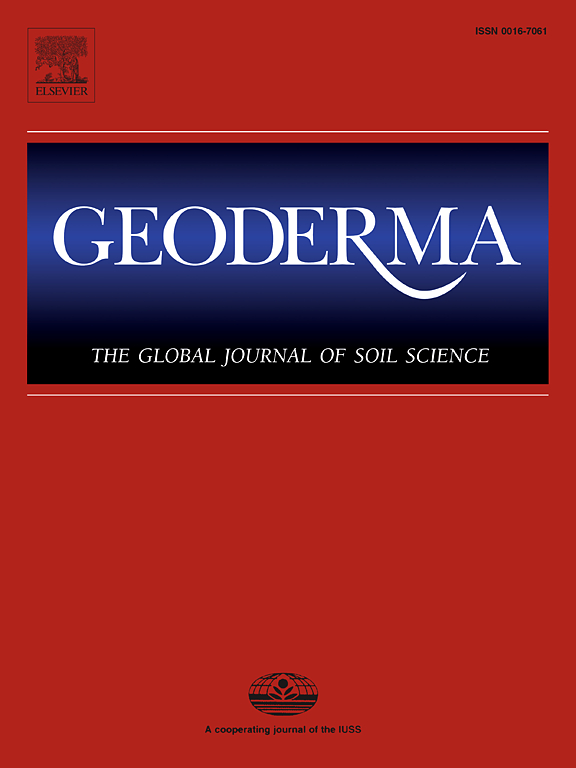Evaluation framework for the generation of continental bare surface reflectance composites
IF 5.6
1区 农林科学
Q1 SOIL SCIENCE
引用次数: 0
Abstract
Soils play a pivotal role in supporting ecosystems, human health, food security, and climate regulation. Since several years, temporal composites of bare soil reflectances derived from multispectral satellite data are used as input for soil property modeling. Due to the importance of these model inputs, the quality of the surface reflectance composites (SRC) is essential. The quality depends on the precise selection of pixels that are free of green and dry vegetation, cloud contamination and other atmospheric disturbances.
However, there is a lack of suitable concepts and tools to evaluate the impact of the diverse processing parameters for the generation of SRC, especially for large areas such as continents. This study presents a novel approach to evaluate the process of computing bare SRCs across large geographical areas. It can estimate the theoretical limit achievable with defined processing parameters (spectral indices, thresholds, specific filtering, etc.) and it is also suitable to compare the performance of different SRC concepts from the literature. The performance is derived from the angular spectral distance between reference spectra derived from the LUCAS survey and the SRC spectra. It is demonstrated that a linear combination of two spectral indices complemented with a regional threshold dataset keep the complexity of threshold data sets low while performing well across Europe. The results also show that regionalization is as crucial as the choice of the index itself. The additional outlier removal focusing on clouds and haze marginally improved the SRC at the continental scale but can be very effective for areas with more frequent clouds. The proposed method offers two main advantages. First, it allows for parameter customization tailored to the region of interest, or, at minimum, to areas well represented by the reference data. Second, it facilitates the systematic evaluation of successive adaptations in the SRC generation process, eliminating the labor-intensive and error-prone task of visually comparing images to assess improvements in the SRC final product. The final bare surface reflectance composite for Europe and adjacent regions provids a robust foundation for future large-scale soil and bare surface monitoring.
大陆裸面反射率合成物生成评价框架
土壤在支持生态系统、人类健康、粮食安全和气候调节方面发挥着关键作用。多年来,从多光谱卫星数据中获得的裸露土壤反射率的时间复合材料被用作土壤属性建模的输入。由于这些模型输入的重要性,表面反射率复合材料(SRC)的质量至关重要。其质量取决于像素的精确选择,这些像素不受绿色和干燥植被、云污染和其他大气干扰的影响。然而,缺乏合适的概念和工具来评估不同处理参数对SRC生成的影响,特别是对于像大陆这样的大面积区域。本研究提出了一种新的方法来评估跨大地理区域计算裸src的过程。它可以估计在定义的处理参数(光谱指数、阈值、特定滤波等)下可以达到的理论极限,也适用于比较文献中不同SRC概念的性能。该性能是由LUCAS巡天得到的参考光谱与SRC光谱之间的角光谱距离得出的。研究表明,两个光谱指数的线性组合与区域阈值数据集相辅相成,使阈值数据集的复杂性保持在较低水平,同时在整个欧洲表现良好。结果还表明,区域化与指数选择本身同样重要。针对云和雾霾的额外异常值去除在大陆尺度上略微改善了SRC,但对于云层更频繁的地区可能非常有效。所提出的方法有两个主要优点。首先,它允许对感兴趣的区域进行参数定制,或者至少允许对参考数据很好地表示的区域进行参数定制。其次,它有助于系统地评估SRC生成过程中的连续适应,消除了通过视觉比较图像来评估SRC最终产品改进的劳动密集型和容易出错的任务。最终得到的欧洲及邻近地区裸地反射率复合数据为未来大规模土壤和裸地监测提供了坚实的基础。
本文章由计算机程序翻译,如有差异,请以英文原文为准。
求助全文
约1分钟内获得全文
求助全文
来源期刊

Geoderma
农林科学-土壤科学
CiteScore
11.80
自引率
6.60%
发文量
597
审稿时长
58 days
期刊介绍:
Geoderma - the global journal of soil science - welcomes authors, readers and soil research from all parts of the world, encourages worldwide soil studies, and embraces all aspects of soil science and its associated pedagogy. The journal particularly welcomes interdisciplinary work focusing on dynamic soil processes and functions across space and time.
 求助内容:
求助内容: 应助结果提醒方式:
应助结果提醒方式:


